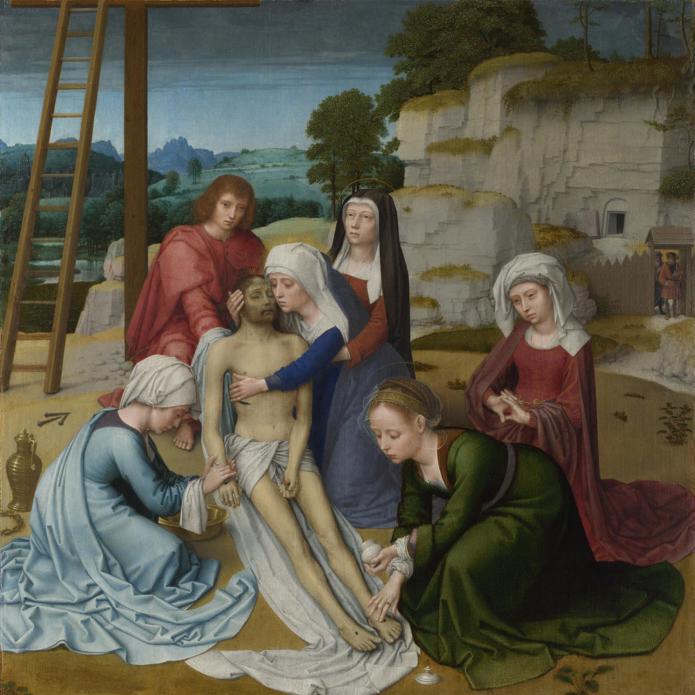Gerard David, 'Lamentation', 1515-23
About the work
Overview
Christ’s body has just been brought down from the Cross and is being prepared for burial – the square door to his tomb is visible in the rock face on the right. His mother embraces him tenderly, while Mary Magdalene anoints his feet. Another woman washes his wounds with water from a brass basin while Saint John the Evangelist, in red, supports the body on its shroud.
The men entering through a gate on the right are the two secret converts to Christianity: Nicodemus, who brought spices to embalm Christ’s body, and Joseph of Arimathea, who gained permission to bury him after the Crucifixion.
It is likely that this painting formed part of a series of the life of Christ painted by David as part of polyptych (a multi-panelled altarpiece). His Adoration of the Kings, also in the National Gallery’s collection, probably comes from the same altarpiece.
Key facts
Details
- Full title
- Lamentation
- Artist
- Gerard David
- Artist dates
- active 1484; died 1523
- Part of the series
- Two Panels from an Altarpiece
- Date made
- 1515-23
- Medium and support
- oil on wood
- Dimensions
- 63 × 62.1 cm
- Acquisition credit
- Bequeathed by Mrs Joseph H. Green, 1880
- Inventory number
- NG1078
- Location
- Not on display
- Collection
- Main Collection
- Previous owners
- Frame
- 20th-century Replica Frame
Provenance
Additional information
Text extracted from the ‘Provenance’ section of the catalogue entry in Lorne Campbell, ‘National Gallery Catalogues: The Fifteenth Century Netherlandish Schools’, London 1998; for further information, see the full catalogue entry.
Bibliography
-
1833J.D. Passavant, Kunstreise durch England und Belgien, Frankfurt am Main 1833
-
1835E. Foster & Son, A Catalogue of the Very Rare Collection of Italian, Ancient German, Dutch and Flemish Pictures: The Property of Charles Aders, Esq., London, 1 August 1835
-
1854G.F. Waagen, Treasures of Art in Great Britain: Being and Account of the Chief Collections of Paintings, Drawings, Sculptures, Illuminated Mss. […], vol. 2, trans. E. Eastlake, London 1854
-
1881National Gallery, Descriptive and Historical Catalogue of the Pictures in the National Gallery: Foreign Schools, London 1881
-
1924M.J. Friedländer, Die altniederländische Malerei, 14 vols, Berlin 1924
-
1925Thomas Agnew & Sons, Loan Exhibition of Pictures by Old Masters, London 1925
-
1929F. Dülberg, Niederländische Malerei der Spätgotik und Renaissance, Berlin 1929
-
1945Davies, Martin, National Gallery Catalogues: Early Netherlandish School, London 1945
-
1953M. Davies, The National Gallery, London, Les Primitifs flamands. I, Corpus de la peinture des anciens Pay-Bas méridionaux au quinzième siècle 3, 2 vols, Antwerp 1953
-
1955Davies, Martin, National Gallery Catalogues: Early Netherlandish School, 2nd edn (revised), London 1955
-
1967M.J. Friedländer, Early Netherlandish Painting, eds N. Veronée-Verhaegen and H. Pauwels, trans. H. Norden, 14 vols, Leiden 1967
-
1968B. Völker, Die Entwicklung des erzählenden Hablfigurenbildes in der niderländischen Malerei des 15. und 16. Jahrhunderts, Phd Thesis, Georg-August-Universität 1968
-
1973The National Gallery, The National Gallery: January 1971 - December 1972, London 1973
-
1975D.G. Scillia, Gerard David and Manuscript Illumination in the Lowlands, Phd Thesis, Case Western Reserve University 1975
-
1980E.J. Mundy, Gerard David Studies, Princeton 1980
-
1987Davies, Martin, National Gallery Catalogues: The Early Netherlandish School, 3rd edn, London 1987
-
1998Campbell, Lorne, National Gallery Catalogues: The Fifteenth Century Netherlandish Paintings, London 1998
-
2001
C. Baker and T. Henry, The National Gallery: Complete Illustrated Catalogue, London 2001
About this record
If you know more about this painting or have spotted an error, please contact us. Please note that exhibition histories are listed from 2009 onwards. Bibliographies may not be complete; more comprehensive information is available in the National Gallery Library.
Images
About the series: Two Panels from an Altarpiece

Overview
These two paintings – the Adoration of the Magi and the Lamentation – most likely come from a polyptych (an altarpiece made up of several panels) painted by Gerard David and his assistants in the workshop he set up in Antwerp in 1515. They are roughly the same size and the figures are painted on the same scale, and have been together since at least the nineteenth century. They may have come from a lost altarpiece showing scenes from the life of Christ.









